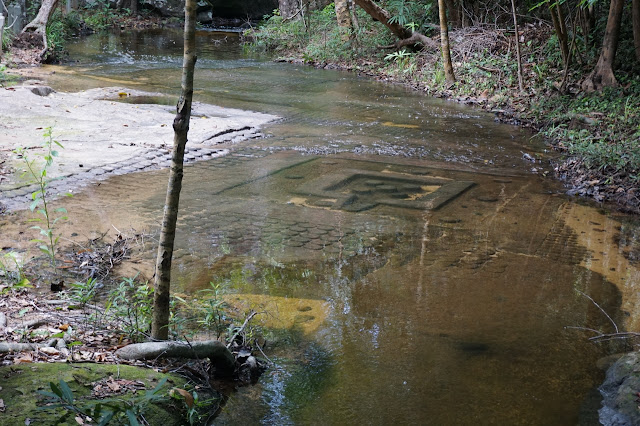 |
| Banteay Srey carvings |
Our final days in Siem Reap and after a day on the bikes yesterday, we were going to spend a bit of the time sitting in a tuk tuk as we planned to visit some of the more remote sites.
 |
| Banteay Srey, smaller than many other temples |
First on our hit list was Banteay Srey, built during the latter half of the 10th century by a king called Rajendravarman. It is of comparatively miniature proportions and built out of a pink sandstone which still has a lovely colour.
 |
| What grass? |
The guide book says this is a peaceful, isolated setting, don't be fooled, this is no longer the case as this site is now a major attraction with interpretation centres (very useful) boat rides (not for us) and restaurants. Oh, and coachloads of people arrive around 10 am, fortunately just as we were leaving.
 |
| Kbal Spean, Vishnu reclining |
Further away from Angkor War is the site of Kbal Spean, one of the tributaries of the Seim Reap river which flows through the main Angkor Wat group.
 |
| Underwater carvings |
A forty five minute walk up hill gets you to a river bed with sculptures carved into it, including hundreds of lingas. This continues for about 150m and you have to look very closely to spot them all (we missed some).
 |
| Some of the hundreds of lingas carved into the river bed |
Our final temple of the day was Banteay Samre, a restored temple (built during the reign of Suryavarman in the first half of the 12th century) just outside the main Angkor Wat group which means this truly was a peaceful setting and somewhere to escape the crowds.
 |
| Ruth, trying to stop Banteay Samre walls collapsing |
For our last day we thought we'd try to catch a sunrise, but away from the crowds at Angkor Wat, great idea, but it was too cloudy for a proper sunrise, however we were away from the crowds, just the two of us and a temple attendant!
 |
| Bakheng sunrise |
Bakheng was carved out of a hillside during the late 9th to early 10th century under the reign of Yasovarman, it takes about 15 minutes to walk up to the top. As well as there being no sunrise, at the moment (and for the next two years) there is extensive renovation taking place so the views are partially obstructed by scaffolding. That said, they are still good.
 |
| Bakheng summit |
After Bakheng we visited two minor sites nearby, both small and peaceful with no one about, maybe it was still too early?
 |
| Steep steps ascending Baksei Chamkrong |
Baksei Chamkrong was a reasonable sized affair in a fairly standard format, the second site was much smaller but there were some intact inscriptions in a doorway.
 |
| The writing's on the wall |
Baphoun was next, followed by the final temples of the day, and of our visit to Siem Reap, The Khleangs and the Sour Prat Towers.
 |
| Sour Prat, now there's a name that doesn't translate well |
There are two Khleangs, North and South, built at different times and their purpose is unknown. The North Khleang was built first ( late 10th century) and it is thought the South Khleang was built later (early 11th century) for symmetry!
 |
| Gingerbread cottages |
The Sour Prat Towers were built later (early 13th century), and in between the Khleangs, there are twelve in total, all identical and also of unknown function.
 |
| Baphoun |
Baphoun (or Bapoun) was built just as the Normans invaded Britain (middle of the 11th century). A one hundred and seventy two metre long raised causeway leads to an enormous temple mountain.
 |
| Plucking birds from a tree |
Inside the temple are many carvings like the one above, showing details of everyday life? The carvings are a little niave, but there are many of them and they do have a certain charm.
 |
| Spot the monk? |
At the West side of the temple mountain, the collapsed walls have been reused (about 16th century) and built into a giant statue of a reclining Buddha, difficult to make out at first, but if you look close enough and squint a bit you can see his head.
 |
| Reclining Buddha |
So that's our tour of Siem Reap and the temples completed, now we're off to Sa Pa.
No comments:
Post a Comment